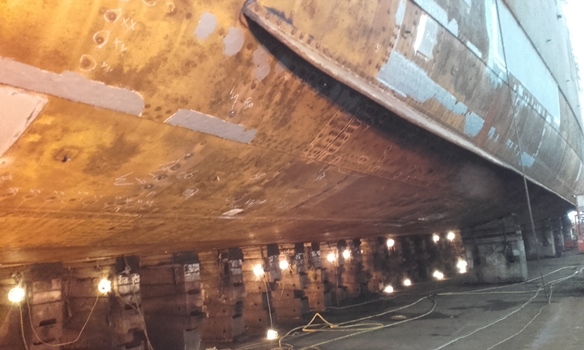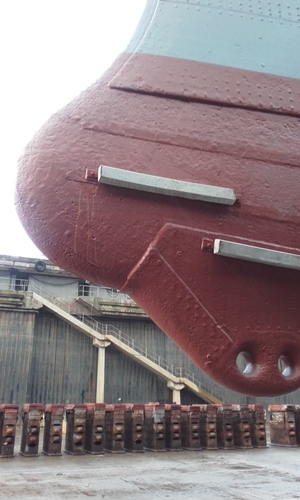The HMS Caroline, owned by the National Museum of the Royal Navy (Portsmouth, United Kingdom), is a decommissioned C-class light cruiser that engaged in combat service during World War I and served as an administrative center in World War II. Launched and commissioned in 1914, the 3,700-ton vessel is a historic artifact and popular tourist destination as a museum ship.
Unfortunately, more than 100 years of exposure to the elements have taken a heavy toll on the structure—especially considering that it was originally designed for just 20 years of service.
So in late 2016, the ship was sent to the nearby Harland and Wolff shipyard in Belfast, Ireland, to undergo a hull refurbishment. It had been 30 years since the vessel’s last overhaul, and numerous components, fuel tanks, and storage areas below the waterline had taken on water. This resulted in numerous leaks, as well as a very pitted surface. Welding was only an option for repairing non-leaking hull areas that were strong enough to withstand hot works, so the solution also needed cold-bonding characteristics.

Simply finding a repair material capable of bonding to the poor substrate under those conditions was challenging enough. But in addition to issues with the substrate, rapid cure times were also a requirement, since the dry dock at the shipyard was already booked for another ship repair.
Marine surveyors settled on two cold-curing materials from polymer repair composites and industrial protective coatings manufacturer Belzona (Harrogate, United Kingdom) as best suited to meet those challenges, with regional provider SPP Engineering Services (Fowey, United Kingdom) chosen as the contractor to apply the system.
Two-Part Composites
After consultation, Belzona 1111 (Super Metal)† was one of two repair materials selected as suitable composites for the job. This product, a two-part repair composite for metal repair and resurfacing, is based on a solvent-free epoxy resin reinforced with a silicon-steel alloy. The material will not corrode, resists a wide range of chemicals, and is suitable for contact with potable water.
The other repair material selected was Belzona 1212†, a two-part, surface-tolerant epoxy composite engineered specifically for in situ application to wet, oil-contaminated, and underwater surfaces. The solvent-free material exhibits rapid cure and strong adhesion to manually prepared substrates. Both materials are capable of curing within hours.
The highest possible product performance was required for this project, as this ship will be a high-profile floating museum open to the public, an on-site applicator explains.
Installing the System
Prior to the application, the vessel’s entire substrate was grit blasted and cleaned. Forced heating of the working area was conducted to keep the substrate and material above a temperature of 10 °C. From there, the repair materials were to be applied directly onto the leaking and damaged areas to seal the leaks and reinforce the weakened areas.
 Based on the massive size of the vessel and the urgency to complete it quickly, a team of mixers, runners, and applicators worked simultaneously to apply the repair solutions. The solvent-free epoxy resin reinforced with a silicon-steel alloy was used first to fill in badly corroded areas.
Based on the massive size of the vessel and the urgency to complete it quickly, a team of mixers, runners, and applicators worked simultaneously to apply the repair solutions. The solvent-free epoxy resin reinforced with a silicon-steel alloy was used first to fill in badly corroded areas.
The original job specifications also called for reinforced epoxy resin to be used to seal rivets that leaked fuel from internal storage tanks on the ship. However, upon installation, the contractors realized a solution was needed that was more tolerant of the leak-contaminated surfaces.
Because of that, the two-part epoxy composite was selected as an alternative. According to the manufacturer, this material is effective at displacing contaminants from the substrate via a strong electronic affinity with the metallic substrate that allows the epoxy to penetrate the profile and create a strong mechanical bond.
The contractors had already planned to use it for small portions of the job, but they found out quickly that a larger quantity was required.
Return to Service
In all, only 6 kg of the original repair material was used on the deck level, while over 100 kg of the specialized alternative was applied to seal the leaks due to the substrate conditions.
The job was successfully completed within weeks, and the ship floated back to its moorings at the Alexandra Dock in Belfast’s Titanic Quarter before the end of 2016, with no leaks or delamination seen.
With all other refurbishment works complete, the HMS Caroline is expected to reopen for the peak of the summer 2017 tourism season.
Source: Belzona, belzona.com.
†Trade name.